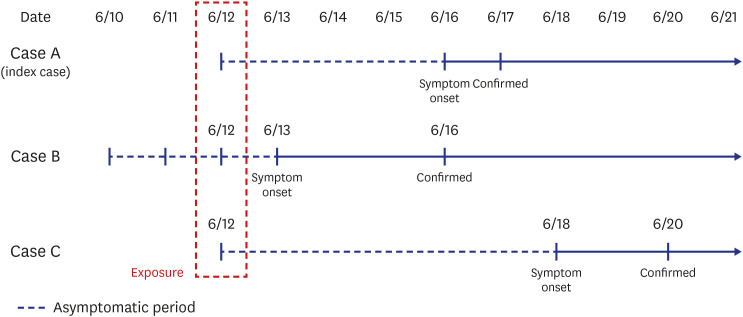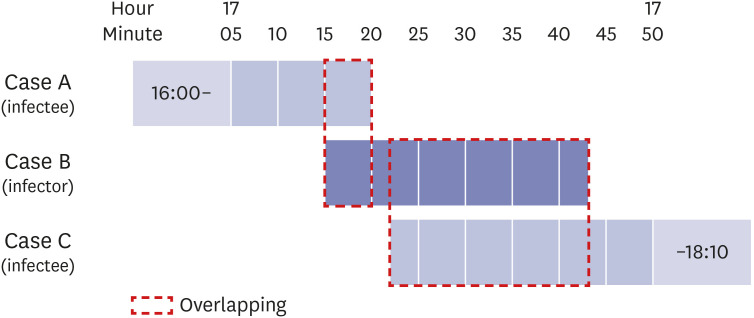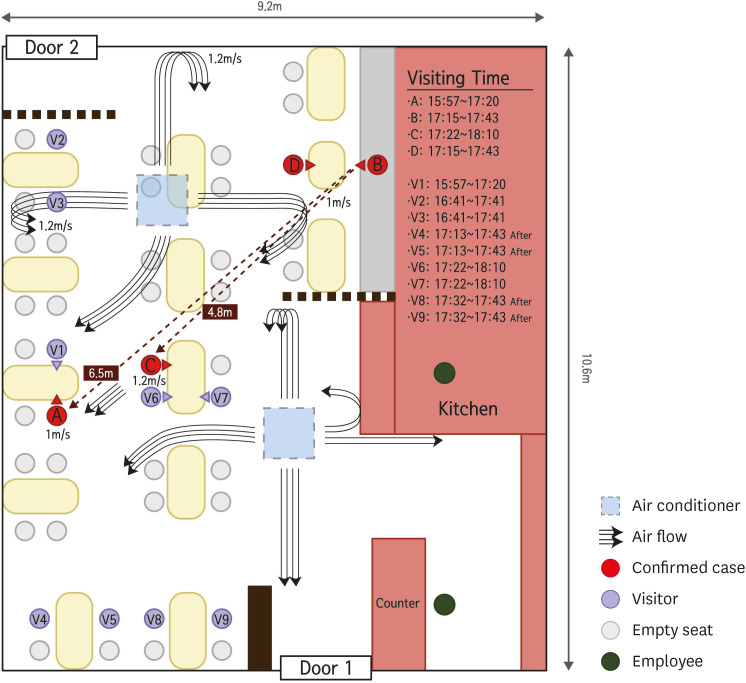J Korean Med Sci.
2020 Dec;35(46):e415. 10.3346/jkms.2020.35.e415.
Evidence of Long-Distance Droplet Transmission of SARS-CoV-2 by Direct Air Flow in a Restaurant in Korea
- Affiliations
-
- 1Department of Preventive Medicine, Jeonbuk National University Medical School, Jeonju, Korea
- 2Jeonbuk Center for Infectious Disease Control and Prevention, Jeonju, Korea
- 3Korea Disease Control and Prevention Agency, Cheongju, Korea
- 4Division of Health Care, Jeonbuk Provincial Government, Jeonju, Korea
- 5Department of Aerospace Engineering, College of Engineering, Jeonbuk National University, Jeonju, Korea
- KMID: 2509042
- DOI: http://doi.org/10.3346/jkms.2020.35.e415
Abstract
- Background
The transmission mode of severe acute respiratory syndrome coronavirus 2 is primarily known as droplet transmission. However, a recent argument has emerged about the possibility of airborne transmission. On June 17, there was a coronavirus disease 2019 (COVID-19) outbreak in Korea associated with long distance droplet transmission.
Methods
The epidemiological investigation was implemented based on personal interviews and data collection on closed-circuit television images, and cell phone location data. The epidemic investigation support system developed by the Korea Disease Control and Prevention Agency was used for contact tracing. At the restaurant considered the site of exposure, air flow direction and velocity, distances between cases, and movement of visitors were investigated.
Results
A total of 3 cases were identified in this outbreak, and maximum air flow velocity of 1.2 m/s was measured between the infector and infectee in a restaurant equipped with ceiling-type air conditioners. The index case was infected at a 6.5 m away from the infector and 5 minutes exposure without any direct or indirect contact.
Conclusion
Droplet transmission can occur at a distance greater than 2 m if there is direct air flow from an infected person. Therefore, updated guidelines involving prevention, contact tracing, and quarantine for COVID-19 are required for control of this highly contagious disease.
Figure
Cited by 1 articles
-
Frequent Occurrence of SARS-CoV-2 Transmission among Non-close Contacts Exposed to COVID-19 Patients
Jiwon Jung, Jungmin Lee, Eunju Kim, Songhee Namgung, Younjin Kim, Mina Yun, Young-Ju Lim, Eun Ok Kim, Seongman Bae, Mi-Na Kim, Sun-Mi Lee, Man-Seong Park, Sung-Han Kim
J Korean Med Sci. 2021;36(33):e233. doi: 10.3346/jkms.2021.36.e233.
Reference
-
1. World Health Organization. Coronavirus disease 2019 (COVID-19): situation report-195. Updated 2020. Accessed July 30, 2020. https://www.who.int/docs/default-source/coronaviruse/situation-reports/20200802-covid-19-sitrep-195.pdf.2. Park K, Kim Y, Yeom H, Hwang I, Kwon J, Kim M, et al. Weekly report on the COVID-19 situation in the Republic of Korea (as of July 25, 2020). Public Health Wkly Rep. 2020; 13(31):2264–2278.3. Ministry of Economy and Finance. Flattening the curve on COVID-19 - how Korea responded to a pandemic using ICT. Updated 2020. Accessed July 30, 2020. http://english.moef.go.kr/pc/selectTbPressCenterDtl.do?boardCd=N0001&seq=4879.4. National Law Information Center. Infectious Diseases Control and Prevention Act [Act number 16725]. Updated 2020. Accessed July 30, 2020. http://www.law.go.kr/LSW/eng/engLsSc.do?menuId=2§ion=lawNm&query=infectious&x=0&y=0#liBgcolor5.5. COVID-19 National Emergency Response Center, Epidemiology & Case Management Team, Korea Centers for Disease Control & Prevention. Contact transmission of COVID-19 in South Korea: novel investigation techniques for tracing contacts. Osong Public Health Res Perspect. 2020; 11(1):60–63. PMID: 32149043.6. Park YJ, Cho SY, Lee J, Lee I, Park WH, Jeong S, et al. Development and utilization of a rapid and accurate epidemic investigation support system for COVID-19. Osong Public Health Res Perspect. 2020; 11(3):118–127. PMID: 32528817.
Article7. Corman VM, Landt O, Kaiser M, Molenkamp R, Meijer A, Chu DK, et al. Detection of 2019 novel coronavirus (2019-nCoV) by real-time RT-PCR. Euro Surveill. 2020; 25(3):2000045.
Article8. Wu F, Zhao S, Yu B, Chen YM, Wang W, Song ZG, et al. A new coronavirus associated with human respiratory disease in China. Nature. 2020; 579(7798):265–269. PMID: 32015508.
Article9. Kim JM, Chung YS, Jo HJ, Lee NJ, Kim MS, Woo SH, et al. Identification of coronavirus isolated from a patient in Korea with COVID-19. Osong Public Health Res Perspect. 2020; 11(1):3–7. PMID: 32149036.
Article10. Li Q, Guan X, Wu P, Wang X, Zhou L, Tong Y, et al. Early Transmission Dynamics in Wuhan, China, of Novel Coronavirus-Infected Pneumonia. N Engl J Med. 2020; 382(13):1199–1207. PMID: 31995857.11. Pung R, Chiew CJ, Young BE, Chin S, Chen MI, Clapham HE, et al. Investigation of three clusters of COVID-19 in Singapore: implications for surveillance and response measures. Lancet. 2020; 395(10229):1039–1046. PMID: 32192580.12. Nishiura H, Linton NM, Akhmetzhanov AR. Serial interval of novel coronavirus (COVID-19) infections. Int J Infect Dis. 2020; 93:284–286. PMID: 32145466.
Article13. Ki M. Task Force for 2019-nCoV. Epidemiologic characteristics of early cases with 2019 novel coronavirus (2019-nCoV) disease in Korea. Epidemiol Health. 2020; 42:e2020007. PMID: 32035431.
Article14. Park YJ, Choe YJ, Park O, Park SY, Kim YM, Kim J, et al. Contact tracing during coronavirus disease outbreak, South Korea, 2020. Emerg Infect Dis. 2020; 26(10):2465–2468. PMID: 32673193.
Article15. Park SY, Kim YM, Yi S, Lee S, Na BJ, Kim CB, et al. Coronavirus disease outbreak in call center, South Korea. Emerg Infect Dis. 2020; 26(8):1666–1670. PMID: 32324530.
Article16. World Health Organization. Scientific brief. Modes of transmission of virus causing COVID-19: implications for IPC precaution recommendations. Updated 2020. Accessed July 12, 2020. https://www.who.int/news-room/commentaries/detail/modes-of-transmission-of-virus-causing-covid-19-implications-for-ipc-precaution-recommendations.17. Wei J, Li Y. Airborne spread of infectious agents in the indoor environment. Am J Infect Control. 2016; 44(9 Suppl):S102–8. PMID: 27590694.
Article18. van Doremalen N, Bushmaker T, Morris DH, Holbrook MG, Gamble A, Williamson BN, et al. Aerosol and surface stability of SARS-CoV-2 as compared with SARS-CoV-1. N Engl J Med. 2020; 382(16):1564–1567. PMID: 32182409.
Article19. Morawska L, Milton DK. It is time to address airborne transmission of COVID-19. Clin Infect Dis. Forthcoming 2020. DOI: 10.1093/cid/ciaa939.20. Dbouk T, Drikakis D. On coughing and airborne droplet transmission to humans. Phys Fluids (1994). 2020; 32(5):053310. PMID: 32574229.
Article21. Lu J, Gu J, Li K, Xu C, Su W, Lai Z, et al. COVID-19 outbreak associated with air conditioning in restaurant, Guangzhou, China, 2020. Emerg Infect Dis. 2020; 26(7):1628–1631. PMID: 32240078.
Article22. European Center for Disease Prevention and Control. Heating, ventilation and air-conditioning systems in the context of COVID-19 (22 June 2020). Updated 2020. Accessed November 5, 2020. https://www.ecdc.europa.eu/en/publications-data/heating-ventilation-air-conditioning-systems-covid-19.
- Full Text Links
- Actions
-
Cited
- CITED
-
- Close
- Share
- Similar articles
-
- Erratum: Correction of Text in the Article “Evidence of Long-Distance Droplet Transmission of SARS-CoV-2 by Direct Air Flow in a Restaurant in Korea”
- Clinical implications of coronavirus disease 2019 in neonates
- Air and Environmental Contamination Caused by COVID-19 Patients: a MultiCenter Study
- Air filtration and SARS-CoV-2
- COVID-19 and Breastfeeding




